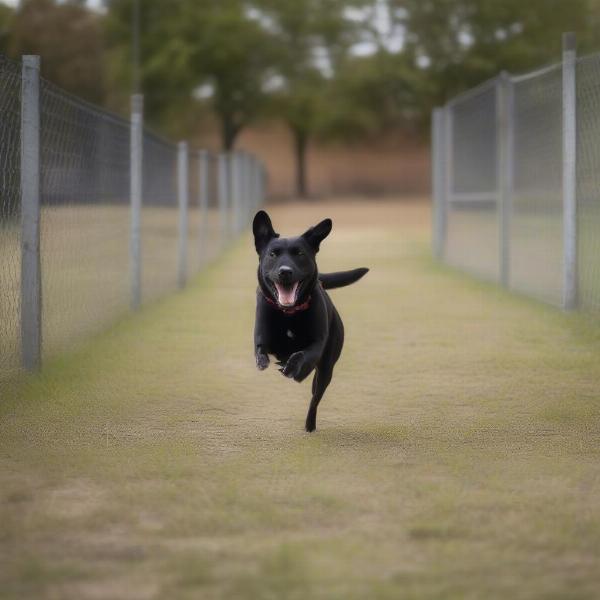Choosing a dog that thrives off-leash requires careful consideration of breed characteristics, training dedication, and a commitment to responsible pet ownership. A “good off-leash dog” isn’t born, it’s made through consistent training, socialization, and a strong bond with their owner. This article explores breeds known for their off-leash reliability and provides essential training tips to help you achieve off-leash success with your canine companion.
Breeds Prone to Off-Leash Success
Certain breeds are naturally predisposed to off-leash reliability due to their intelligence, trainability, and desire to please their owners. While no breed is guaranteed to be perfect off-leash without training, breeds like Golden Retrievers, Labrador Retrievers, and Border Collies often excel in off-leash environments due to their inherent herding or retrieving instincts, which encourage them to stay close and attentive to their owners. Similarly, smaller breeds like Poodles and Cavalier King Charles Spaniels, known for their intelligence and affectionate nature, can also be excellent candidates for off-leash adventures with proper training.
Essential Training for Off-Leash Dogs
Regardless of breed, consistent and positive reinforcement training is crucial for any dog destined for off-leash activities. Start with basic obedience commands like “sit,” “stay,” “come,” and “leave it.” A solid recall is paramount for off-leash safety. Practice these commands in controlled environments with gradually increasing distractions before venturing into more open spaces. Socialization is equally important, exposing your dog to various sights, sounds, and other dogs from a young age will help them develop confidence and appropriate social skills, reducing the likelihood of reactivity or fear-based behaviors when off-leash.
 Dog practicing off-leash recall training
Dog practicing off-leash recall training
Safety First: Off-Leash Considerations
Even with the most well-trained dog, safety should always be the top priority. Be mindful of local leash laws and regulations, and always respect the rules of public spaces. Consider using a long training lead during the initial stages of off-leash training to provide a safety net and prevent your dog from straying too far. Be aware of potential hazards in the environment, such as traffic, wildlife, or other dogs, and be prepared to intervene if necessary. Carrying high-value treats or toys can also be helpful in reinforcing recall and maintaining your dog’s focus.
Building a Strong Bond for Off-Leash Harmony
A strong bond between dog and owner is the foundation of successful off-leash adventures. Spend quality time with your dog, engaging in activities they enjoy, such as playing fetch, going for hikes, or simply cuddling on the couch. This strengthens your connection and builds mutual trust, making your dog more likely to listen and respond to your commands even when off-leash.
Conclusion
Achieving good off-leash behavior requires a combination of choosing a suitable breed, dedicating time to training, prioritizing safety, and cultivating a strong bond with your canine companion. While some breeds may have a natural inclination for off-leash success, consistent training and responsible pet ownership are essential for any dog to thrive in an off-leash environment. By following these guidelines, you and your furry friend can enjoy the freedom and joy of off-leash adventures safely and responsibly.
FAQ
- Which breeds are best for off-leash activities? Breeds like Golden Retrievers, Labrador Retrievers, Border Collies, Poodles, and Cavalier King Charles Spaniels are often well-suited for off-leash adventures due to their trainability and temperament.
- How can I train my dog for off-leash success? Start with basic obedience commands, focus on a strong recall, socialize your dog extensively, and use positive reinforcement methods.
- Is it safe to let my dog off-leash in public spaces? Always be mindful of local leash laws and potential hazards. Consider using a long training lead initially and be prepared to intervene if necessary.
- What should I do if my dog doesn’t come when called off-leash? Do not chase your dog. Instead, try crouching down and calling them in a happy, encouraging voice. Having high-value treats or toys can also help.
- How can I strengthen my bond with my dog for better off-leash control? Spend quality time with your dog, engage in activities they enjoy, and build mutual trust through positive interactions.
- Are there any specific tools that can help with off-leash training? Long training leads, whistles, and high-value treats or toys can be helpful tools during off-leash training.
- What if my dog is reactive to other dogs when off-leash? Seek professional guidance from a certified dog trainer or behaviorist to address reactivity issues and ensure safe off-leash experiences.
ILM Dog is a leading international pet website dedicated to providing expert advice on all aspects of dog care and training. We offer a wealth of information on dog breeds, health, nutrition, behavior, and much more. From puppy care to senior dog support, we are your one-stop resource for all your canine needs. For expert advice tailored to your dog’s unique needs, contact us at [email protected] or call +44 20-3965-8624. ILM Dog is committed to helping you build a strong and happy relationship with your furry friend.